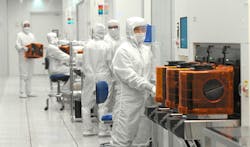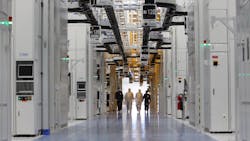This article appeared in Electronic Design and has been published here with permission.
What you'll learn:
- Impact of the Chips and Science Act.
- How are companies investing in attracting skilled talent.
- What more can be done to expand the talent pool.
The U.S. is on the brink of a new semiconductor manufacturing boom, leaving companies in urgent need of technicians to staff their new fabs and engineers to design the chips that these facilities will churn out. And unless things change, there soon may not be enough skilled chip workers in the U.S. to go around.
A top trade group for the U.S. semiconductor industry issued a report claiming there will not be enough skilled engineers and other workers to support their expansion plans, leaving it 67,000 workers short by 2030.
The way the semiconductor industry is growing, it will need a U.S. workforce of about 460,000 by the end of the decade, up from about 345,000 this year, according to a new study released by the Semiconductor Industry Association (SIA) and Oxford Economics.
But students aren’t graduating from universities and colleges fast enough. At the current rate, the U.S. will not produce enough qualified workers to fill even half of these newly created positions, said the organization.
Time to Act on the Chips Act
The talent shortage poses a risk to the U.S.’s ambitions to boost its domestic manufacturing capabilities.
In 2022, the U.S. enacted the Chips and Science Act to allocate around $39 billion in subsidies and other incentives to convince semiconductor firms to build fabs or otherwise expand their footprint on U.S. soil.
Most of the major players in the U.S. semiconductor ecosystem, such as Intel, have said they will apply for the funding. Non-U.S. companies, including TSMC, intend to expand their presence stateside as well.
The Commerce Department is overseeing the subsidies created by the bill, which President Biden signed around a year ago. The measure also created a 25% investment tax credit for purchases of fab equipment.
The Chips Act has transformed the U.S. into a magnet for manufacturing investments related to chips. But with the construction boom comes the need for workers with technical skills to fill roles at new facilities.
Many semiconductor companies are already struggling with an inability to hire qualified workers to build and run new U.S. facilities. TSMC has pushed out mass-production at its new plant in Arizona to 2025, citing a shortage of skilled labor. The contract chipmaking giant warned that it doesn’t have enough skilled workers to install equipment at the fab, which it previously said would be ready to go by 2024.
According to TSMC, the plan is to send technicians from overseas to train local workers and assist with the installation. Apple is one of the companies that intends to use chips built at TSMC’s Arizona factory.
The SIA/Oxford report concluded that from all of the unfilled jobs in the industry’s future, 39% will be targeted at technicians that install, configure, operate, and maintain the state-of-the-art equipment in a fab. Most of the workers that qualify for these jobs will have certificates or two-year degrees.
Taking on the Talent Shortage
Nonetheless, increasing the pipeline of talent amid the rapid industry’s expansion is bound to be an uphill battle.
Top U.S. universities and colleges are already taking it upon themselves to do something about it. Last year, Purdue University launched what it said was the nation’s first “comprehensive” degree program in semiconductors, which will focus on educating graduate and undergraduate students. The program spans from traditional in-person courses to a wide range of degrees, internships, and virtual classes or lab work.
Out of all the job openings highlighted by the SIA, around 35% will be for electrical engineers with four-year degrees or computer scientists, while 26% will be engineers at the master’s or PhD level.
For its part, the U.S. semiconductor industry has invested in and engaged in programs to recruit, train, and employ a skilled workforce. Across the nation, companies have formed partnerships with top universities, community colleges, laboratories, and regional education networks, while others have—and continue to—contribute to apprenticeship programs and technical schools to upskill their workers and find fresh talent.
But U.S. semiconductor makers, flush with funding from the Chips and Science Act, are getting more serious about ramping up a new wave of qualified workers. For instance, Micron Technology is trying to expand access to science- and engineering-related education to students of all ages in Boise, Idaho region, where it plans to spend $15 billion on construction of the first new memory chip fab in the U.S. in years.
Intel, one of the companies at the forefront of the U.S. boom in chip manufacturing, has pledged to work closely with a wide range of universities, colleges, and other organizations to help widen its talent pool. Working with Arizona’s Maricopa Community Colleges system, the company created a 10-day certificate program to train students on the basics of working in a semiconductor fab, putting them on the path to becoming technicians.
Next Steps for the U.S.
While companies and schools alike are taking steps to address the scarcity of skilled chip workers, more must be done to close the gap, according to the report. For its part, the SIA urged the U.S. government to take the lead on several fronts.
The trade group said the U.S. broadly needs to do a better job convincing students to pursue degrees in science, technology, engineering, and math (STEM), while creating more opportunities for them to do so.
At the same time, chip companies need to give students considering a career in electrical engineering or computer science, and graduates who already have the appropriate skills, more incentive to join the field.
The report said the U.S. also needs to work harder at recruiting and retaining the technical and engineering talent that comes out of its world-class universities. At U.S. universities, more than 50% of the graduates with master’s degrees in engineering and 60% with a Ph.D. are citizens of other countries.
Whether for personal reasons or because of immigration policy that prevents them from living stateside, the study said about 80% of the master's graduates and 25% of the students that earn doctorates depart the U.S. after graduation. Accordingly, the study stated that the U.S. needs to enact immigration reforms that make it easier for international students to stay in the country after graduation and to find jobs.
While the talent shortage may be disruptive to U.S. chipmakers, the threat it poses will affect more than just the semiconductor industry. There’s a lack of engineering and technical talent across the U.S. economy, and the report estimates that approximately 1.4 million jobs will go unfilled by 2030.


